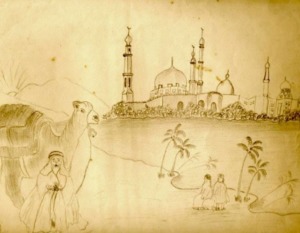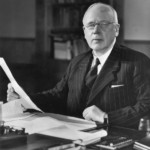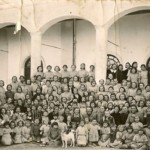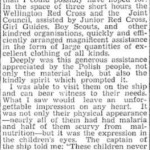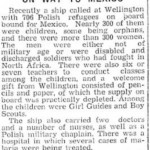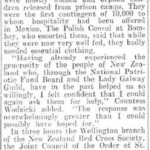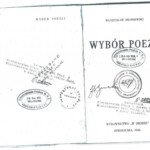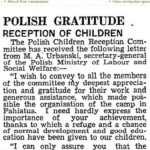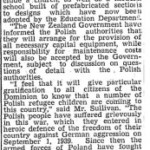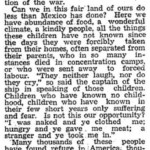Polish Refugees in New Zealand 1944-1951
Exhibitions
Farewell to Isfahan
Krystyna Skwarko: The author of the idea to bring Polish children to New Zealand had been Countess Wodzicka when a ship carrying a few hundred Polish orphans from Persia to Mexico stopped in Wellington for a few days in 1943. She talked to Janet Fraser about the possibility of a similar scheme for this country and the idea soon became a reality. Through innumerable speeches and meetings the countess inspired the people of New Zealand to this most noble undertaking.
After being invited to join the “Polish Children’s Hospitality Committee”, Countess Wodzicka became the chief champion of the whole cause and devoted an enormous amount of time to advising the committee and directing its operations. (p51-52)
…In the same year (1944) the Polish Minister of Social Welfare, Mr Stanczyk, came from London to visit all the homes in lsfahan. It was during his visit that Delegate Haluch told us that because the British and Polish Armies were moving out, the camps in Teheran and the homes in lsfahan were going to be moved. He also told us that the war could not end favourably for Poland so there was no chance of us going back there. Then Mr Haluch told us the Polish Government in London had accepted an invitation from the Prime Minister of New Zealand, Mr Peter Fraser, for about 700 children and 100 adults to travel to his country and remain there till the end of the war.
The remaining Polish inhabitants left in lsfahan would be transferred to Syria.
Our stay in Home No. 7, therefore, was to last barely eight months. I was asked to become principal of the boys’ school that would go to New Zealand. After discussing the matter with my husband who was now in lsfahan after being exempted by the Polish Army Medical Commission from further military service, I accepted the offer without hesitation.
We began immediately to organise the new boys’ school in Homes No. 1 and 1A. To go on the long trip we selected the orphans, children whose fathers were fighting in Italy, children whose parents were not in Persia, and the children of those adults who would accompany them in the ship and work for the children in New Zealand. Then we had to find teachers and supervisors.
It was not an easy task to persuade women to care for about 300 boys. Most of the men, and there were only a few in lsfahan, did not want to go as far away as New Zealand.
Some brothers or sisters could not leave at that time because of illness, so there were several changes to the list of boys selected to travel. The final list was made up of orphans and children who were separated from their parents because of the war.
We worked for days and nights checking clothing, issuing suitcases, text books, library books and so on. Time was limited. It was already July and we had to leave at the end of September.
At the same time the principal of the girls’ school, Mrs J. Zerebecka, was getting 390 girls together with teachers and supervisor in Home No. 6. Also making preparations for the journey were the principal of the high school, Mrs Zieciak, who selected 55 girls in Home No. 2 and Mrs Tietze who collected 52 preschoolers in No.8.
Included in the staff going to New Zealand were the chaplain, Father M. Wilniewczyc, a doctor, Dr E. Czochanska, a dentist, Dr J. Budzyna Dawidowska, a treasurer, Mr S. Skwarko and two Ursuline nuns, Sister M. Aleksandrowicz, as the religious instructor, and Sister A. Tobolska as a supervisor. Mr M. Kotlicki and Mr and Mrs Olechnowicz also volunteered to come with us. Apart from the group mentioned above there were also the teachers, supervisors, domestic and administrative staff. Altogether, 100 staff and 733 children.
The children were eager to go. The prospect of seeing a new, little-heard-of country fascinated them. There was no end to the questions about New Zealand. The most important thing that the teachers could tell them was that it was a beautiful country and that the people were very kind. The word “Antipodes” became very popular. There was a lot of interest shown in the life of the Maori people. One of the few available books about the country was called Drama in the Pacific. It was read with great excitement.
Then on September 27, 1944, those staying behind waved us farewell as we left for Ahvaz. We were saying goodbye to lsfahan, the city of mosques and palaces, the city of our Polish Homes, the city that restored physical and mental health to two thousand Polish children. We were leaving behind the ancient Iranian capital with the streets resounding with Polish children singing as they marched in orderly scout ranks. (p47-49)
The Invited; p51-52, 47-49
Voices
Voices
When on 9 June 1943 the US transport ship Hermitage, carrying a group of 706 Polish refugees from Iran to Mexico, anchored for a short time at Wellington, the wife of the Polish Consul, Countess Maria Wodzicka, visited them and conceived an idea of bringing some of the other Polish orphans from Iran to New Zealand.
She shared her idea with Prime Minister Peter Fraser’s wife, and eventually that idea become a reality when Mr Fraser and his government offered hospitality to 733 Polish children and 105 staff who were to accompany them. So the journey from their temporary refuge in Isfahan, Iran, to Pahiatua began. (p24)
…The Polish Children’s Camp in Pahiatua was the very first humanitarian experiment by the New Zealand Government in assisting a large group of refugees to this country. It was not so much a deliberate immigration policy but rather a humanitarian vision by Prime Minister Peter Fraser when he learnt of the Polish children’s plight when they were in the temporary refugee camps in Iran. These letters reveal that he and his government always regarded the children as their guests.
The first letter is dated almost a year before the children’s arrival and the second was written five years later in the year before the camp’s closure. The New Zealand Government had no precedent to follow other than its willingness to give it a go.
To Count Wodzicki, Polish Consul to New Zealand
28 December 1943
My dear Count Wodzicki,
With reference to our discussion concerning the reception of the Polish refugee children in New Zealand and the meeting held in my office on Tuesday, 14 December, I have to inform you that the New Zealand government would be very willing to afford hospitality in New Zealand to a total number of persons, including staff, of say 500 or 700, whichever number your government considered more convenient.
Our whole conception of the scheme is that it should cater for the largest number of children and would, therefore, wish that as many children as possible should be included within the total number who might come to New Zealand. We recognise, of course, that it is essential that sufficient staff should accompany the children, and we would be willing, if the Polish Government so desired, to receive, within the total number of 500 to 700, a number of mothers of the children.
The New Zealand Government would make all arrangements in connection with the establishment of the camp and would provide all necessary capital equipment, such as beds, bedding, furniture, kitchenware, etc. Responsibility for maintenance costs, such as food and clothing, would also be accepted by the New Zealand Government subject to discussion on questions of detail with whatever authority may be nominated by your government.
I understand that, in company with the government officers concerned, you and the Countess Wodzicki visited the Internment Camp in Pahiatua on Wednesday, 15 December. If, after consideration of plans, it is decided that this camp would be suitable for the accommodation of the children, and, generally speaking, it does appear that it will meet all requirements, we would arrange for it to be vacated by its present occupants and made ready for the reception of the children.
I would suggest, on the assumption that the arrangements proposed for the reception of the Polish refugee children in New Zealand are acceptable to your government, that nearer the time when the children will leave, arrangements may be made for the camp commandant designate to travel to New Zealand in advance of the main party. He could, I feel sure, afford us valuable assistance in ensuring that, as far as possible, the layout and facilities of the camp will meet the requirements of the children and staff when they arrive.
P Fraser
Prime Minister
New Zealand’s First Refugees: Pahiatua’s Polish Children (3rd edition); p27-28
Glued to radio sets for the BBC News at eight o’clock every evening, we began to appreciate a little of the atrocious plight of the European populace. Unprotected by a Geneva Convention, civilians are at the mercy of occupying powers. In 1943, we heard that a refugee ship had called at Wellington.
Letter by Maria Wodzicka
Delegate of Polish Red Cross to the Red Cross Society of NZ
Sir, – May I ask indulgence for space in your columns to express to the people of Wellington my heartfelt thanks for the wonderful kindness and generosity recently extended to my fellow-countrymen.
Some time ago, quite unexpectedly, a ship arrived with 700 Polish refugees, mostly women and orphan children, released from prison camps. They were the first contingent of 10,000 to whom hospitality has been offered in Mexico, and the Polish consul in Bombay, who escorted them, told me that while they were now very well fed, they badly needed essential clothing.
Having already experienced the generosity of the people of New Zealand, who through the national Patriotic Fund Board and the lady Galway Guild, have in the past helped us so willingly, I felt confident that I could again ask them for help. The response was overwhelmingly greater than I could possibly have hoped for. In the space of three short hours the Wellington Red Cross and the Joint Council, assisted by the Junior Red Cross , Girl Guides, Boy Scouts, and other kindred organisations, quickly and efficiently arranged magnificent assistance of excellent clothing of all kinds.
Deeply was this generous assistance appreciated by the Polish people, not only the material help but also the kindly spirit which prompted it.
I was able to visit them on the ship and can bear witness to their needs. What I saw would leave an unforgettable impression on my heart. It was not only their physical appearance – nearly all of them had had malaria and half of them scurvy from malnutrition – but it was the expression in the children’s eyes. The captain of the ship told me: “These children never cry: they cause no trouble on board.” And one of the Polish teachers added, “Nor do they laugh.”
I am very sorry that the strict rules of security would not permit some of the people of Wellington to visit these children. Had they been able to do so they would indeed have seen for themselves just what this war has done. One thing more I should like to add. Many sick and wounded New Zealand soldiers returned on the ship. One of the Polish ladies, Madame Tyszkiewicz, a personal friend of mine, told me: “The New Zealand soldiers are not only famous modern warriors they have also some qualities of the noble knights of old, everyone is a perfect gentleman. Tell me please, what kind of a country is this New Zealand that gives her sons?” etc.,
What can we in New Zealand do? We asked Countess Wodzicka to come and speak at our October meeting, to tell us why these Polish children are adrift and about the scheme to provide a haven for some of them. The Government invited Red Cross to join the Polish Children’s Hospitality Committee. Fired by the countess‘s moving account, this Branch, Junior included, is already at work in anticipation of the request for clothes and toys.
The Geneva Connection, Red Cross in New Zealand; p78-79
To New Zealand. On 27 September 1944 we left Isfahan with its warm and sunny climate, which had helped us to regain our strength and health.
I will never forget Iran a country of mosques, palaces, gardens and shops full of decorative silver and copper.
New Zealand’s First Refugees: Pahiatua’s Polish Children (3rd edition); p69
After deliverance from Soviet bondage, our life in hospitable Iran continued to be full of surprise and rapid change. Rumours of an invitation from New Zealand’s Prime Minister Peter Fraser for temporary refuge in his country circulated for almost a year.
Ever prepared, our guardians compiled lists of the mainly orphaned children for relocation to New Zealand, cautious not to separate siblings who had already lost their parents or were separated from them, though not always succeeding. My sister Bogda and I were on this list.
Getting volunteer staff to accompany us was not easy, as the war was drawing to its end and everyone wanted to return home to Poland. Few adults relished the idea of a journey into the unknown through the Japanese- patrolled southern oceans. However, 105 adults with a sense of patriotic duty did volunteer.
In July 1944 our secondary school began a series of lectures about New Zealand, of which we knew nothing. They were like Hans Christian Andersen’s fairy tales of a paradise with democracy, excellent climate and rich soil with two harvests in one year, and plentiful fruit, cattle and sheep. Only the earthquakes were worrisome. After the inhumanity of our Soviet oppressors, we were told of gentle, honest and hardworking New Zealanders who never locked their doors (and most people here did not lock them in those days). It was unbelievable.
New Zealand’s First Refugees: Pahiatua’s Polish Children (3rd edition); p36-37
After two-and-half peaceful years of temporary asylum in Isfahan, it was time to move on.
In 1944, the children were being evacuated to South and East Africa, Mexico, India and Canada. The last group was evacuated to Lebanon in 1945. I was listed on the third transport to leave Iran for Africa but, because my sisters had trachoma (an in fectious eye disease), I had to stay behind and wait anxiously for the next transport. There seemed no place for us to go because all the British colonies were now full with Polish refugees and we weren’t sure what would happen to us.
Then came an invitation from New Zealand’s Prime Minister Peter Fraser for a group to come to New Zealand. The news of our departure was a shock. What is happening? Instead of getting closer to Poland, I am actually getting even further away from my homeland to the very ends of the world!
New Zealand First Refugees: Pahiatua’s Polish Children(3rd edition); p57
I arrived in Isfahan in 1942. At the end of 1944 time came for departure. Some would go to Lebanon, others to New Zealand. Where was I to go?
Mr Dabrowski, Head of Home number One, suggested I go to Lebanon.
My husband was then in the Polish army and hoped to be able to return to Poland soon. I found myself on the list for New Zealand, but not wishing to go that far from Europe, I took my name off the list. By then, Mrs Skwarko left with the children for Basra. That night I had a dream – my husband came to me, carrying two suitcases and asked me why I wasn’t on my way to New Zealand, as we wouldn’t be able to return to Poland. By morning, I decided to go and register for transport to New Zealand. Mr Winiarczyk and others were very surprised at the change in my decision.
A Bouquet of Thoughts and Reminiscences; p30
Towards the end of September, on 24th and 27th, a large group, in which there were 731 children and young people and 105 staff left for New Zealand.
This was a great event in our peaceful life, because it meant that almost half the Polish children would be leaving Isfahan. For those who left and those who stayed behind it was a very emotional farewell, because during those two years we had become very fond of each other. (p132)
…From the beginning of 1944, we already knew that New Zealand was inviting Polish orphans to settle there. Preparations began. The Guider, Stefa Kozera, was going with the children. We knew that it would be much easier to supervise a transport of 700 children on a long journey as a properly organised “Scouting expedition” , therefore immediately we prepared two courses for Leaders.
Exactly one year after the Tehran team put us through a proper training we were able to train the young Company, Patrol and Pack Leaders ourselves. When the five-day course was completed with satisfactory results, we held a farewell camp-fire to which the District Commissioner and guests were invited . We said goodbye to those who were leaving with heavy hearts, for we had shared a portion of our lives, and now we might never meet again . We had had such hopes that one day we should return to Poland together and now we were being dispersed yet further around the world . All we could do was to help in loading the transports and to “keep smiling” . We became so attached to these friends especially the little ones… On 23rd and 27th September 1944 our Scouts, Guides, Cubs and Brownies left Isfahan. (p281)
Isfahan – City of Polish Children; p132, 281
After some time later I learnt that I was going to New Zealand, which did not make much impression on me since I had no idea where that country was. One of the girls knew someone who had read a book “Drama in the Pacific” in which New Zealand was, and the book had said there were cannibals there.
But our teacher explained that it was a beautiful country, in which very honest people lived, where theft was unknown, and everything was spotlessly clean.
They gave us things for the journey from the stores; socks -1 pair; shoes-1 pair; sheet-1; towels-2; soap-1; toothpaste-1; comb-1; shoe laces-1 pair; blanket-1 and….string 10 metres!
Taking into account the fact that when I came out of hospital in Teheran, where I had spent some months, my “property” consisted of one nightdress, a dressing gown and a woollen cap (because I was completely bald after treatment for impetigo!) and a pair of “knickers” in a little suitcase, I had become immeasurably more wealthy after receiving my travel trousseau.
Someone somewhere gave me a cardboard suitcase. I packed my things and waited for departure. For some time I was transferred from school to school, until at the last moment. I was sent to No. Twenty, from which our party was leaving to New Zealand.
Isfahan – City of Polish Children; p132-133
The New Zealand Prime Minister, Peter Fraser, came on board, accompanied by the Polish consul-general, Count Kazimierz Wodzicki, and his wife, Maria, the Polish Red Cross representative in New Zealand
For Countess Wodzicka this was the culmination of many months’ work in preparation for the arrival of the children. She’d come up with the idea of bringing a group of Polish orphans to New Zealand, when in 1943 she visited a ship carrying a similar “cargo” from Persia to Mexico. The ship had stopped in Wellington to refuel and to restock its food and water supplies for the second half of its journey. The countess was deeply moved by the plight of these children who had been through so much at their young age, and once she realised there were thousands more orphans stranded in Persia she decided to do something about it.
She contacted her friend Janet Fraser, the wife of the New Zealand Prime Minister, and together they came up with a plan to bring some orphans to New Zealand. When Mrs Fraser appealed to her husband for help with this project Peter Fraser embraced the idea wholeheartedly and agreed to invite a group of about 700 of children, plus enough adults to take care of them, offering them shelter in New Zealand until the end of the war. And so this great humanitarian act was initiated. Now his guests had finally arrived and the Prime Minister came on board to meet them. There was a brass band welcoming the arrivals with cheerful music. Press photographers and a television crew were also present to record this momentous occasion.
Alone; p148
The ship [ Editor note: The US transport ship Hermitage’ carrying women and children from Iran to Mexico made a brief stop in Wellington, New Zealand in 1943.] was visited by Countess Maria Wodzicka, who was the Polish Red Cross representative in New Zealand and the wife of the Polish consul in that country, Professor Kazimierz Antoni Wodzicki. Having learned in the last minute of the ship’s arrival that there were Polish children on board, she decided to see them. She was shocked when she saw the impoverished Polish orphans and appealed to the people of Wellington for material help for the children.
The appeal was met with a favourable response, with donations of large quantities of clothing, shoes, medicine, writing material and toys.
While aboard the ship, Maria Wodzicka conceived an idea of bringing to New Zealand a similar group of Polish children, mainly orphans and their caregivers still remaining in Iran. She shared this idea with her friend Janet Fraser, the wife of the New Zealand Prime Minister Peter Fraser, who persuaded her husband to invite Polish children to this country for the duration of the war. Both women considered that to achieve their objective the proposal needed the acceptance of the widest section of the community. In June 1943 they began a wide-ranging campaign to ensure that the children would arrive at the earliest possible time.
Though the Polish Government-in-Exile in London did not see the removal of its children to such far off place as a priority, Prime Minister Peter Fraser sent an official invitation to bring a group of orphans to his country, assuring his government’s care and support for the children. The office of the Polish Ministry of Labour and Social Welfare in Isfahan was worried that only support personnel would be invited to go to New Zealand – without teachers and educators. There was a real fear that once in New Zealand, the Polish orphans would be split up and sent to private homes, farms or welfare institutions – with a consequent loss of national identity. (This proved to be a legitimate concern, because that indeed was the intention of many in the New Zealand Government and caused friction with the Poles who accompanied the children to that country). The Polish Government-in-Exile held the view that Poland had lost more than one million of its citizens who had died in Russia and was keen not to lose the precious remnants left in Iran. Some added that in time the children would merge into the local population and could even lose their Catholic faith in that mainly Protestant country. In the meantime, the New Zealand proposal was filed away.
Official meetings were held between the Polish representative, Consul Kazimierz Wodzicki and New Zealand’s Prime Minister Peter Fraser to outline the main conditions for the refugee children’s stay in that country. A special Board of Guardians was appointed, among whose members were Janet Fraser and the representatives of the main churches of New Zealand. The vicinity of the Pahiatua township, 160km north of Wellington, was selected as the most appropriate location for the children. A camp already existed there that housed interned enemy aliens from the start of the war.
On 23 December 1943, a few days after these talks, Prime Minister Peter Fraser sent an official invitation to the Polish refugees through the Polish Consul, Kazimierz Wodzicki. Though the main points were settled, namely the invitation and location, they awaited the Polish Government-in-Exile’s decision. Peter Fraser followed this up with an invitation for 700 children and 100 adults to come to New Zealand for the duration of the war. Other matters remained to be resolved. Because of the increased number of refugees agreed upon, more accommodation had to be built at the camp in Pahiatua. Eventually all matters were resolved and in December of 1943 it was decided that: “The New Zealand Government will provide food, clothing, housing and will bear the main costs of equipping the camp, while the Polish Government-in-Exile in London will be responsible for the salaries and wages of the adult Poles and for the children’s pocket money.”
A Priest’s Odyssey; p1- 2;
In 1939 Poland was invaded by both Germany and the Soviet Union. During the next three years, some one and a half million Poles were deported to forced labour camps and prisons in Siberia. Many children were orphaned or became lost or separated from their families.
After the German invasion of the Soviet Union in 1941, an amnesty was declared for captive Poles, in return for the formation of a Polish army to fight the Germans. “As soon as the political amnesty was announced there began an amazing exodus. From all the corners of Russia…, from all the forced labour camps, mines, prisons, from forests and other places of their exile, almost a million-strong mass of Polish people travelled in goods trains, sick, hungry and in rags to reach the south and the Caspian Sea….” Unable to return home because of the war, thousands of Polish children found safety in orphanages set up in the southern Soviet Union under the auspices of the Polish army. Later, about 30,000 Polish women and children, mostly orphans, were taken by the army to temporary refuge in Iran, where they spent the next three years. Unable to cope with the influx of refugees, Iran appealed to the international community for help.
The idea of bringing some of the children to New Zealand came from Countess Maria Wodzicka, the Polish Red Cross delegate in New Zealand and wife of the country’s wartime Polish Consul-General. A ship which passed through Wellington in 1943, carrying hundreds of Polish orphans from Iran to Mexico, gave her the inspiration. She talked to her friend, Janet Fraser, wife of the Prime Minister, about her idea and, with the support of the people of New Zealand, the dream became a reality.
On 23 December 1943 the Prime Minister of New Zealand, the Right Honourable Peter Fraser, wrote to the Polish Consul-General, Count Wodzicki:
With reference to our discussions concerning the reception of Polish refugee children in New Zealand…, I have to inform you that the New Zealand Government would be willing to afford the hospitality in New Zealand to a total number of persons including staff, of say 500 to 700, whichever number your Government considered more convenient. Our whole conception of the scheme is that it should cater for the largest number of children and we would, therefore, wish that as many children as possible should be included within the total number who might come to New Zealand. We recognise, of course, that it is essential that sufficient staff should accompany the children and we would be willing, if the Polish Government so desired, to receive, within the total number of 500 – 700, a number of mothers of the children….
The Polish Consul-General responded:
This latest gesture in providing refuge during these war years for the Polish children will win for ever the love and friendship of all Poles.
The Prime Minister announced the refugee intake in Parliament:
It would be an act of Christian philanthropy and kindness, in which New Zealanders should be pleased to participate, to welcome these children, a few of their parents and attendants, giving them a chance to recuperate.
Some 733 Polish children, many of whom were orphans, and 105 accompanying adults arrived in New Zealand on the troopship USS General Randall on 1 November 1944. twenty-two more children arrived later. The adults in the group were almost exclusively women, since the men were with the army. Many of the women were adjusting to widowhood as well as exile, as they lost their husbands in the war. Some of the children were so young and so traumatised by harrowing experiences of exile and war – including loss of their families – that they did not know who or how old they were, or where they came from.
On arrival, the Polish refugees stayed in an immigration camp in Pahiatua, then named “the Polish Children’s Camp”. (p15-16)
…The Pahiatua camp remained “home” for the Polish children for nearly five years, until they gradually dispersed throughout New Zealand.
Although in its beginnings the Polish intake was not strictly a resettlement programme – New Zealand was only supposed to be a temporary refuge for the duration of the war – it evolved into one to cater to the needs of those first Polish refugees.
After the war, when the political situation in Poland meant it was not feasible for the children to return home in the foreseeable future, New Zealand became their permanent home.
So began New Zealand’s refugee resettlement programme. (p16)
Women Refugees: The New Zealand Refugee Quota Programme; p15-16
Photos
Documents
Acknowledgements
The New Zealand Museum Gallery Room “Polish Refugees in New Zealand – Deportees Forcibly Taken to Siberia, Ex-Servicemen and Displaced Persons” was created by a workgroup from Wellington, New Zealand under the umbrella of the Kresy-Siberia Foundation. The group was led by Irena Lowe (Smolnicki), and assisted by Dr.Theresa Sawicka, Wesław Wernicki, Jackie Rzepka, Adam Manterys and Mary-Anne Morgan (Baziuk).
Theresa and Wesław have provided the team with professional assistance in the field of history. Irena, Jackie, Adam and Mary-Anne are all first generation New Zealanders and descendants of family members forcibly deported from Kresy during World War II, who subsequently came to New Zealand either as children bound for Pahiatua Children’s Camp, or as ex-servicemen and women or displaced persons.
We also acknowledge all those Pahiatua children and adults, ex-servicemen and women, displaced persons and New Zealanders who have written about their own or their family’s experiences in books and journals and provided a wonderful history in text, photos and documents over many decades. The team has not set out to rewrite the history but rather to collate the existing stories in a structure so that the interested readers and the following generations can access the stories on-line and view the history as a mosaic. We are humbled by their experiences.
We are grateful to our sponsors who have enabled the publication of this gallery.

Stowarzyszenie Polskich Kombatantów SPK (Polish Ex-Servicemen’s Association)
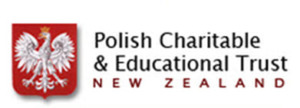
Polish Charitable and Educational Trust New Zealand

The Morgan Foundation

Dr Zbigniew Popławski – in memory of the Popławski family
Andy and Anthony Bogacki – in memory of the Bogacki and Zielinski family
Eugenia Smolnicka – in memory of Michał and Antonina Piotuch
Jackie Rzepka – in memory of the Rzepka family
Steve Witkowski – in memory of the Witkowski family
Bibliography
Sources
Alexandrowicz, S.Monica 1998. “Z Lubcza na Antypody“. Seria: Ocalić od zapomnienia -1. Zgromadzenie Siótr Urszulanek SJK.
Beaupré-Stankiewicz, Irena, Danuta Waszczuk-Kamieniecka, and Jadwiga Lewicka-Howells. 1989. Isfahan – City of Polish Children. 3rd ed. London: Association of Former Pupils of Polish Schools, Isfahan and Lebanon.
Beaupré-Stankiewicz, Irena, Danuta Waszczuk-Kamieniecka, and Jadwiga Lewicka-Howells. 1987. Isfahan – Miasto Polskich Dzieci. 1st ed. London: Kolo Wychowanków Szkól Polskich, Isfahan i Liban.
Chibowski, Ks. Andrzej. 2012. Kapłańska Odyseja Ząbki. Original language edition. Polska: Apostolicum.
Chibowski, Dr. Andrzej. 2013. A Priest’s Odyssey. 1st English- language edition. Wellington, New Zealand: Future Publishing.
Dabrowski, Stanislaw. 2011. Seeds in the Storm. Waikanae, NZ: Maurienne House.
Ducat, Michelle, Mealing, David, Sawicka Theresa, and Petone Settlers Museum. 1992. Living in Two Worlds: The Polish Community of Wellington Wellington: Petone Settlers Museum/Te Whare Whakaaro o Pito-one
Jagiello, Józef. 2005. One Man’s Odyssey. Edition 2005. Józef Jagiello.
Department of Labour, New Zealand Immigration Service. 1994. Refugee Women: The New Zealand Refugee Quota Programme. Wellington: Department of Labour, New Zealand Immigration Service.
Lowrie Meryl. 1981 The Geneva Connection, Red Cross in New Zealand. Wellington: New Zealand Red Cross Society.
Manterys, Adam, Stefania Zawada, Stanislaw Manterys, and Józef Zawada. 2008. New Zealand’s First Refugees: Pahiatua’s Polish Children (2nd ed.). Wellington: Polish Children’s Reunion Committee.
Manterys, Adam, Stefania Zawada, Stanislaw Manterys, and Józef Zawada. 2012. New Zealand’s First Refugees: Pahiatua’s Polish Children (3rd ed.). Wellington: Polish Children’s Reunion Committee.
Manterys, Adam, Stefania Zawada, Stanislaw Manterys, and Józef Zawada. 2006. Dwie Ojczyzny: Polskie dzieci w Nowaj Zelandii Tułacze wspomnienia. Warszawa: Społeczny Zespól Wydania Książki o Polskich Dzieciach w Nowej Zelandii.
New Zealand Education Deptment. 1945. “Polish Children in New Zealand.” New Zealand School Journal, 1937-vol. 39 No 5, Part III:147-152.
Polish Women’s League. 1991. Wiązanka myśli i wspomnie / Koło Polek = A Bouquet of thoughts and reminiscences. Wellington, N.Z.: The League.
Rodgers, Owen. 2011. Adventure Unlimited – 100 years of Scouting in New Zealand 1908-2005. Wellington: Scout Association of New Zealand.
Ronayne Chris. 2002. Rudi Gopas – a biography. David Ling Publishing Limited.
Skwarko, Krystyna. 1972. Osiedlenie Młodzieży Polskiej w Nowej Zelandii w r. 1944. Londyn, Poets’ and Painters’ Press.
Skwarko, Krystyna. 1974. The Invited. Wellington: Millwood Press.
Spławska, Władysława Seweryn. 1993. Harcerki w Zwiądzku Harcerstwa Polskiego: Poczatki i Osiągnięcia w Kraju oraz 1939-1949 poza Krajem. Głowna Kwatera Harcerek ZHP poza Krajem.
Suchanski, Alina. 2006. Polish Kiwis: Pictures from an Exhibition. Christchurch: Alina Suchanski.
Suchanski, Alina. 2012. Alone : an inspiring story of survival and determination. Te Anau, N.Z.: A. Suchanski.
van der Linden, Maria. 1994. An Unforgettable Journey. Second Revised ed. Palmerston North: Dunmore Press.
Tomaszyk, Krystine. 2004. Essence. Palmerston North: Dunmore Press.
Tomaszyk, Krystyna. 2009a. Droga i Pamięć: Przez Syberie na Antypody. Warszawa: Wydawnictwo Trio.
Zdziech, Dariusz. 2007. Pahiatua – “Mała Polska” małych Polaków. “Societas Vistulana” .
Other Books
Beck, Jennifer, and Lindy Fisher. 2007. Stefania’s Dancing Slippers. Auckland: Scholastic New Zealand. [Children’s Book]
Domanski, Witold (Vic). 2011. A New Tomorrow: A story of a Polish-Kiwi family. Masterton, NZ: Tararua Publishing.
Jaworowska, Mirosława. 2011. Golgota i Wybawienie: Dzieci Pahiatua od Syberii do Nowej Zelandii – Cztery Pory Roku jak Cztery Pory Życia Warszawa: Studio Jeden.
Kałuski, Marian. 2006. Polacy w Nowej Zelandii. Toruń, Poland: Oficyna Wydawnicza Kucharski.
Lochore, R. A. 1951. From Europe to New Zealand: An Account of our Continental European Settlers. Wellington: A. H. & A. W. Reed in conjunction with the New Zealand Institute of International Affairs.
Lubelski, Katolicki Uniwersytet. 2007. Z Sybiru na drugą półkulę : wojenne losy Polskich dzieci z Pahiatua. Lublin: Wydawn. KUL.
Pobóg-Jaworowski, J. W. 1990. History of the Polish settlers in New Zealand, 1776-1987. Warsaw: CHZ Ars Polona.
Ogonowska-Coates, Halina. 2008. Krystyna’s Story: A Polish refugees journey. Dunedin: Longacre Press.
Roy-Wojciechowski, John, and Allan Parker. 2004. A Strange Outcome: The Remarkable Survival Story of a Polish Child. Auckland: Penguin Books.
Szymanik, Melinda. 2013. One Winter’s Day in 1939. Auckland: Scholastic. [Children’s Book]
Turol, Sophia. 2010. Sophia’s Challenging Journey: Self-published.
Wiśniewska-Brow, Helena. Give Us This Day. Victoria University Press.
Other Materials
CraftInc. Films. 2015. Polish Children of Pahiatua. 70th Reunion – HD. Wellington: CraftInc Films. Produced by Wanda Lepionka and David Strong. [Film].
Gillis, Willie Mae. 1954. The Poles in Wellington, New Zealand. Edited by Department of Psychology. Vol. No. 5 Publications in Psychology. Wellington: Victoria University College. [Research]
Krystman-Ostrowski, Teresa Marja. 1975. The Socio-Political Characteristics of Polish Immigrants in Two New Zealand Communities, Department of Politics, University of Waikato, Hamilton. [Thesis]
National Film Unit. 1944. Weekly Review 169. Wellington: National Film Unit.
O’Brien, Kathleen. 1966. The Story of Seven-Hundred Polish Children. Wellington: New Zealand National Film Unit. [Film]
Ogonowska-Coates, John Anderson in collaboration with Halina. 1996. Exiles: The Story of a Polish Journey. Wellington: Ace of Hearts Production in Association with Polish Television. [Film]
Sawicka-Brockie, Theresa. 1987. Forsaken Journeys, Department of Anthropology, Auckland University, Auckland. [PhD Thesis]
Stowarzyszenie Polaków w Christchurch. 2004. Poles Apart: Historia 733 Polskich Sierot. Christchurch: Canterbury Telivision (CTV). [Film]
Tomaszyk, Krystyna. 2009b. The Story of the Polish Children in Isfahan – Iran 1942-1944. [DVD]
Indexes Of Names
Dundalk Bay – Ship carrying Displaced Persons to New Zealand
Goya Voyage 2 – Ship carrying Displaced Persons to New Zealand
Goya Voyage 3 – Ship carrying Displaced Persons to New Zealand
Orphanage – Pahiatua – New Zealand
S.S. “RANGITIKI” – Ship carrying ex-servicemen related to Pahiatua orphans to New Zealand
SS Hellenic Prince – Ship carrying Displaced Persons to New Zealand
Contact
Kresy-Siberia (New Zealand)
PO Box 853 Wellington 6140 New Zealand
e-mail: NZ@Kresy-Siberia.org
